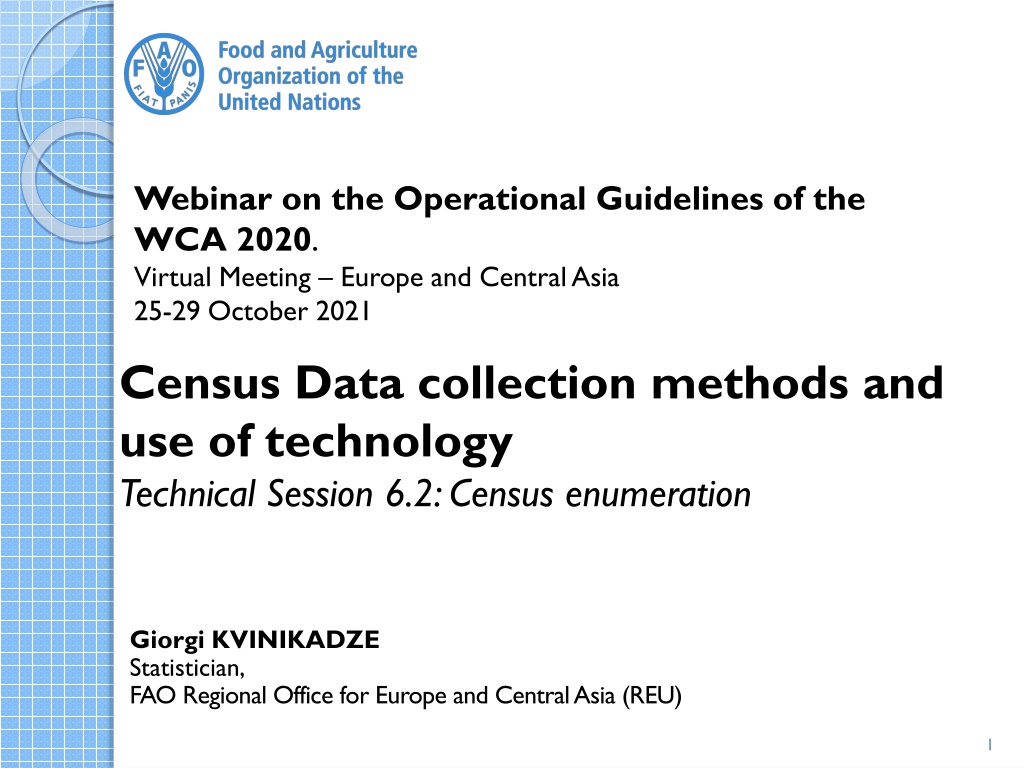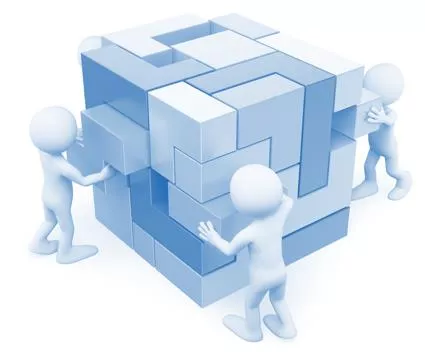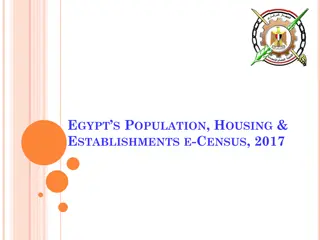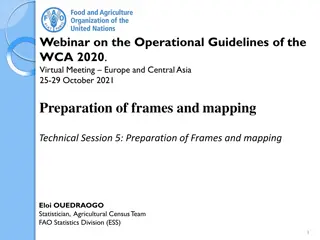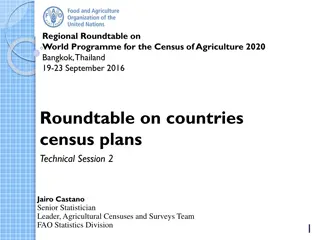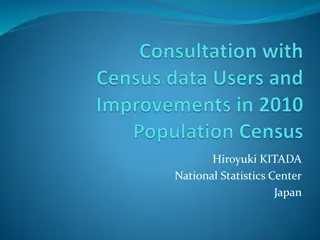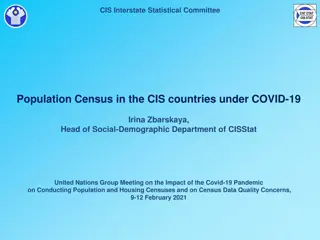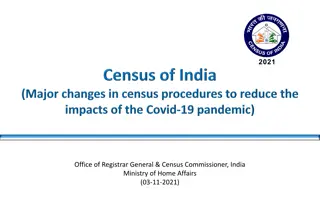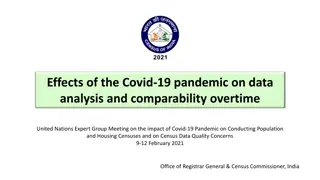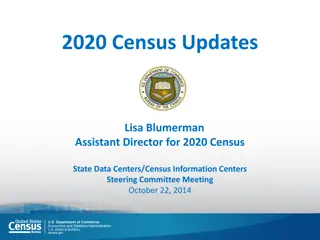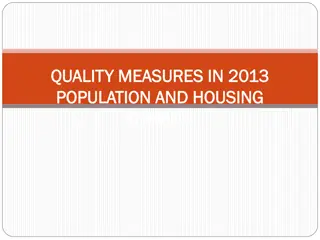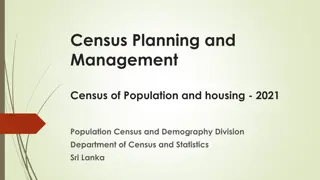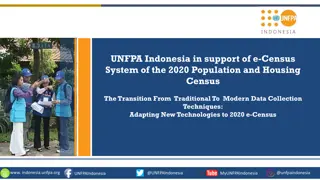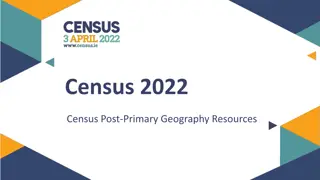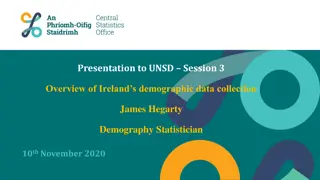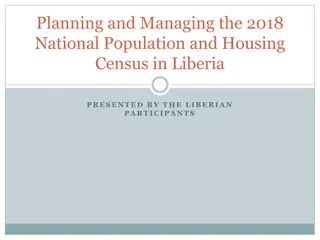Methods of Data Collection for Agricultural Census
Data collection methods for agricultural census involve face-to-face and remote approaches, influenced by factors like costs, literacy, and respondent willingness. Face-to-face interviews are common, offering advantages in quality and consistency, but face challenges in obtaining accurate information in developing countries.
Download Presentation

Please find below an Image/Link to download the presentation.
The content on the website is provided AS IS for your information and personal use only. It may not be sold, licensed, or shared on other websites without obtaining consent from the author. Download presentation by click this link. If you encounter any issues during the download, it is possible that the publisher has removed the file from their server.
E N D
Presentation Transcript
Webinar on the Operational Guidelines of the WCA 2020. Virtual Meeting Europe and Central Asia 25-29 October 2021 Census Data collection methods and use of technology Technical Session 6.2:Census enumeration Giorgi KVINIKADZE Statistician, FAO Regional Office for Europe and Central Asia (REU) 1
CONTENT 1. Data collection methods Face-to-face data collection Remote data collection methods 2. Use of new technologies 3. Special problems 2
Methods of collecting data during an agricultural census There are several ways of collecting data during a census and the choice between data collection methods is influenced by several factors, including: costs coverage of the target population literacy and education of respondents flexibility of asking questions respondents' willingness to participate and response accuracy availability of holding level accounting or book keeping. TWO ways: Face-to-face data collection Remote data collection methods. Usually these methods are used in combination. 3
Face-to-face data collection Face-to-face, through paper or electronic questionnaires, is the most widely used for agricultural censuses, particularly in developing countries. Face-to-face advantages: Enumerators can be well instructions and procedures; In areas of relatively low literacy, the meaning and purpose of the census questions can be rephrased. Face-to-face interviews elicit prompt replies, and cases of reluctance to cooperate can generally be settled during the course of the enumeration itself; Within an EA, the information is likely to have fairly uniform quality and consistency; More complex questions can be included in the census than would otherwise be possible. has the following trained in the concepts, 4
Face-to-face data collection (contd) Data can be obtained through interview with the respondent or by objective measurement or both. Interview Challenges in developing countries: respondents have no quantitative concepts, and even if they do, many of the agricultural operations are such that the respondents fail to recall consequently errors are introduced into the census data. difficult items such as agricultural labour: reliable information usually cannot be obtained with a single interview. data on production of agricultural commodities may not be readily obtained in one visit (harvest is spread over the year). data on the number of trees, or on age and species of livestock numbers, etc. are difficult to obtain through simple oral inquiries. accurate information and 5
Face-to-face data collection (contd) Interview (cont d) Different ways of procuring the data from respondents will have to be developed depending on their socio-economic status. Pre-test surveys should provide guidelines on the methodology to be adopted to collect data on specific items. To get the right answer to a question often a number of indirect questions will have to be used . May be necessary to give background explanations in the dialect of the respondent in order to communicate proper meaning of the original questions. It may be also recommended to note the data and other information obtained through conversation with the respondent and summarize in the form of explicit answers on the main questionnaire: Space may be dedicated, such as the back of the sheets, to record the data and other information. Provision should be made also in electronic questionnaires for recording such information. 6
Face-to-face data collection (contd) Objective measurement: may be necessary for some items such as area and yield measurements, and usually on a sampling basis. Area measurement can be done in different ways: (i) by actual measurements in the field or (ii) by using aerial photography or remote sensing imagery. FAO recommends the use of GPS in place of compass traversing method *. Whatever method is applied, actual field measurements remains time-consuming because each field has to be visited by the enumerators. For this reason measurements are done only on a sampling basis and never by complete enumeration. *The compass and rope method, or traversing, is considered the gold standard of land area measurement. 7
Remote data collection methods Methods which do not require enumerators meeting in person for interviewing respondents. Different methods Drop-off/Mail-back (DO-MB) or Pick-up by enumerators (DO-PKE) The census office mails paper-based questionnaires to local or field enumerators. Field enumerators deliver the questionnaires to the respondents residence with instructions on how to complete the questionnaire and how to mail it back in an enclosed postage-paid envelope or to be picked-up physically by the enumerators. Mail-out/Mail-back (MO-MB) The census office mails paper-based questionnaires directly to respondents with instructions on how to complete the questionnaire and how to mail it back in an enclosed postage-paid envelope. Completed questionnaires are mailed back to the census office. 8
Remote data collection methods (contd) Paper-Assisted Telephone Interviewing (PATI) The census office respondents by phone and writing data on paper-based questionnaires. A notice letter and paper-based questionnaire could be mailed prior to the collection period with instructions on how to complete it to prepare respondents for the phone interview. This activity could be centralized in the census office or in communal-local offices. Computer-Assisted Telephone Interviewing (CATI) Similar to PATI except that interviewers enter the data into electronic questionnaires. has interviewers contacting 9
Remote data collection methods (contd) Computer-Assisted Self-Interviewing (CASI) or Computer-Assisted Web Interviewing (CAWI) with online electronic questionnaire The census office sends census notice to respondents with instructions on: a) how to access the web questionnaires with a secure access code; b) a call center for help; and c) instructions on how to complete it. The secure access code is required to authenticate respondents, allowing them to access the application, and notifying the field collection operation once a questionnaire is transmitted by respondents. The CASI/CAWI questionnaire usually includes navigational help information, drop-down menus and online edits. Edits can be simplified in order to reduce respondent frustration with errors and its associated response burden. Skip patterns are built in CASI/CAWI questionnaires so only questions related to the type of holding operations are presented to respondents. 10
Comparison of data collection methods FACE-TO- FACE REMOTE DATA COLLECTION DO- PKE MB Relative scale from Low/less (1) to High/more (5) 4 1 2 DO- MB MO- PA TI CA TI CASI/C AWI PAPI CAPI 3 2 1 5 5 Personal contact Identification of new and active holdings Timeliness data collection (a) Timeliness data processing Data quality and coherence Failed-edit follow-up calls Follow-up non- response Response burden 5 5 2 2 2 2 5 5 2 2 1 3 4 5 2 2 1 1 2 3 5 5 3 5 1 2 1 2 5 5 3 5 3 3 5 2 1 1 2 1 2 2 5 4 4 5 2 2 4 4 5 3 2 1 3 2
Cost comparison of remote data collection methods FACE-TO- FACE REMOTE DATA COLLECTION DO- MB PKE MB Relative scale from Lower cost (1) to Higher cost (5) DO- MO- PA TI CASI/C AWI CATI PAPI CAPI Collection cost: 2 3 1 1 1 1 4 5 field enumerators (a) 2 1 2 5 4 1 1 1 interviewers (b) 5 5 5 5 1 1 5 1 printing 5 2 5 1 1 1 2 1 mail (c) 5 5 5 4 1 1 4 1 data capture (d) 5 4 5 3 1 1 2 1 failed-edit follow-up follow-up non-response 2 2 2 4 4 4 2 2
Use of technology for census data collection Use of Remote sensing and aerial photos Support to field work of censuses/surveys Satellite images or aerial photos can help enumerators to optimize their displacements and facilitate localization of holdings and fields. Aerial photos or very high-resolution imagery will help the enumerators to access the land and/or locate the holder. Used as paper prints or on a mobile device, imagery will also minimize the obvious declaration and measurement errors. Crop area estimation Two main methods are used to derive crop area statistics from RS (Delince J, 2015): (i) Pixel counting, and (ii) Calibration methods. 13
Example of Ag Census of Morocco Orto-photos (spatial resolution of 30 cm) to identify boundaries of holdings and their plots. Scale 1/5,000 14
Use of technology for census data collection (contd) Use of Handheld GPS: Provides support to field activities: - Geo-referencing plots - Holding location - Measuring the area of a plot or landscape patch It is also used in building frames. Handheld mobile digital devices (smartphones, tablets, etc) : CAPI applications are being developed to leverage these devices for data collection. Most mobile devices contain built-in GPS and are more portable than computers. The devices can be used for CAPI data collection method. When equipped with GPS, they also can be used for geo-referencing holdings, optimizing logistics and supporting enumerators, and for collecting and compiling paradata for effective monitoring of census progress. Examples of this include: Listing exercise is undertaken and enumerators must return to conduct the interview; Questionable responses that require follow-up; Agricultural censuses using modular approach or integrated census survey modality requiring more than one visit. *Paradata: information captured about the interview (e.g. date and time of start, completion, approval, etc.) 15
Use of technology for census data collection (cont d) Mobile devices with GPS Using GPS and paradata for monitoring census progress: Geo-referencing the location of the interviews gives census managers a tool to minimize fabricated data. Plotting geo-references on a map allows census managers to visualize the progress. The daily tabulation of this information allows census managers to closely monitor the progress of activities and even detect fraudulent interviews. Mobile devices for CAPI CAPI can reduce overall cost, improve data quality, and decrease the time between data collection and analysis. Limitations: size and cost, access to data networks and Wi- Fi, access to power in some areas, safety and security. 16
Special problems Kitchen gardens and horticulture crops: single plot grows several vegetables, all sown in separate rows. Crops cultivated simultaneously: two or more different temporary or permanent crops grown simultaneously in the same field or plot. Continuous harvesting: Root crops such as carrots, beetroots, radishes, turnips, sweet potatoes, green corn cobs, etc., can be harvested continuously from the same field throughout the season. Partial harvesting: This refers to so-called "reserve crops" among which is cassava, an important food crop in some developing countries. Scattered fruit trees: The number of fruit trees which are planted along field borders or scattered in fields and in other parts of a holding should be counted separately for each species, classified into those of bearing and non-bearing age. Enumeration of outside parcels: parcels of a holding may be outside the selected primary sampling unit under a separate operator. If too far away, they can be enumerated by the nearest enumerator and the relevant questionnaire passed to the enumerator in charge of the holding. 17
Special problems (contd) Urban and peri-urban agriculture Major difficulty: non-availability of suitable frame and potential high cost for identifying the holdings and building a frame. When important, various actions may be considered to capture the related information: agriculture-section in PHC, use admin sources and use of area frame. Common land and livestock lease: the land not belonging directly to any agricultural holding but land on which common rights apply; the area used by each holding is not individualized. 18
Special problems (contd) Shifting cultivation: it is a system of cultivation where holders clear certain parts in the reservoir of natural vegetation (forest/grass-woodland) for a certain time and abandon them when the soil fertility is depleted. Enumeration of nomadic and semi-nomadic livestock: two types of data collection methods can be used aerial/satellite surveys. Ground surveys implemented through two main ways: Enumeration points Specific ethnics groups or clans. Aerial surveys can be implemented in various ways: Low level aerial surveys, (100-300 meters) above the ground, suited for coverage of extensive, remote areas, inaccessible by other means. Drones and micro-drones may represent another way to gather aerial count data. For more, refer to the Global Strategy guidelines on enumeration of nomadic and seminomadic livestock. (i) ground surveys and (ii) 19
Countries agri-censuses since 2006 using e-questionnaires in Argentina (2008), Brazil (2006), Colombia (2013/2014), Cote d Ivoire (2014/2015), Equatorial Guinea (2015), Cabo Verde (2014/2015),France (2010),French Guyana (2010),Iran (2014), Jordan (2007),Malta (2010),Martinique (2010), Mexico (2007), Morocco (2016), Mozambique (2013/2014), Oman (2012), Saudi Arabia (2015), Thailand (2013),Venezuela (2008) CAPI (2009/2010), Namibia Australia (2010/2011),Italy (2010),Rep.of Korea (2015) CAWI UK (2010) CATI Austria (2010), Brazil (2017), Canada (2011), Estonia (2010), Finland (2010), Iceland (2010), Latvia (2010), Lithuania (2010), the Netherlands (2010), Mexico (2017, pilot census), Poland (2010), Slovenia (2010), Spain (2009/2010), Sweden (2010), USA (2012) CAPI, CAWI, CATI combined 20
Country Experience Lithuania -Agricultural Census 2010 In the AC 2010, Lithuania used CAWI, CAPI and PAPI methods for census data capture. Some census data were collected directly from administrative registers. Census results were disseminated and are accessible online. Data collection started with an e-Census in May June 2010 (CAWI). Farmers who came to a ward office to declare crops through the IACS were surveyed by a census specialist (CAPI). Farmers that did not respond during the e-Census,and did not declare crops,were interviewed from 19 July until 31August 2010,using paper questionnaires (PAPI). Small farms were interviewed from 1 June 2010 until 16 July 2010, using paper questionnaires (PAPI). Agricultural enterprises had to fill in the electronic questionnaire themselves and send it directly to Statistics Lithuania using the electronic statistical reporting portal. Administrative data were also used in the AC, as a source of census data and for validation purposes.
THANK YOU 22
